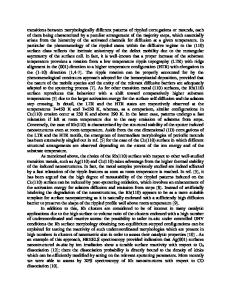Defects Study in Gold Surfaces Produced by Ion Bombardment
- PDF / 927,024 Bytes
- 6 Pages / 612 x 792 pts (letter) Page_size
- 95 Downloads / 354 Views
0960-N08-03
Defects Study in Gold Surfaces Produced by Ion Bombardment E. Carrasco1, O. Rodríguez de la Fuente1, J.M. Rojo1, M.A. García2, and C. de Julián3 1 Departamento de Física de Materiales, Universidad Complutense, Madrid, 28040, Spain 2 Instituto de Magnetismo Aplicado, UCM-CSIC-Renfe, Las Rozas, 28230, Spain 3 Dipartimento di Fisica, Università di Padova, Padova, Italy
ABSTRACT We present new experimental results regarding the surface defect structure of ion bombarded gold surfaces. We report annealing mechanisms of surface defects on reconstructed Au(001) after medium fluence ion bombardment. We show how (001) and (111) gold surfaces can be nanostructured with a certain degree of lateral order by means of high fluence and high flux ion irradiation. We prove that ion irradiation nanostructuring strongly changes optical (plasmonic) properties of gold polycrystalline thin films. INTRODUCTION Among the currently used techniques for surface nanostructuring, ion bombardment is a promising one. The impingement of a low energy ion on a surface creates defects, mainly vacancies and adatoms. A continuous exposure of a macroscopic area to a homogeneous broad ion beam can produce nanometric surface structures, because of the evolution of the individually generated surface defects. Under certain conditions, surface structures can be ordered, showing a well-defined periodicity [1, 2]. Competition between various surface processes favors this selfordering. Ripples are probably the most common structures in this respect [3]. At this point, the knowledge of the atomic processes involved during irradiation is a necessary step to control the generated nanostructures by tuning experimental parameters. In previous works we have described surface defects on Au(001), generated by low energy bombardment at low fluxes, ranging from very low to very high fluences [4]. The 5x20 reconstruction of this orientation results in a rich variety of defects. 2D dislocations are the very initial defects, which turn into vacancy islands after higher fluences. As ion fluence increases, so do grow the vacancy islands, leading to the generation and further disappearance of perpendicular reconstruction domains, until multiple atomic levels are finally exposed at the higher exposures. In this paper we focus on annealing processes of surface defects. We report on the morphology after high ion flux irradiations, which is found to be the optimal condition to create nanostructures, either of single crystals or of polycrystalline thin films. We also show that surface plasmon resonance is sensitive to the changes induced by ion irradiation, opening the way to use optical properties as an external probe to characterize nanostructured surfaces.
EXPERIMENT Experiments have been carried out in a UHV chamber equipped with Auger electron spectroscopy (AES), low energy electron diffraction (LEED) and a homemade scanning tunnelling microscope (STM). Single crystal gold surfaces were prepared by the standard combination of Ar+ ion bombardment and high tempera
Data Loading...










